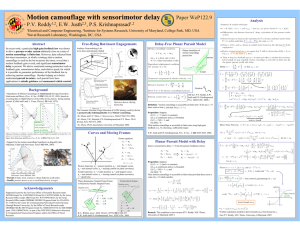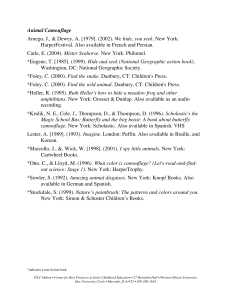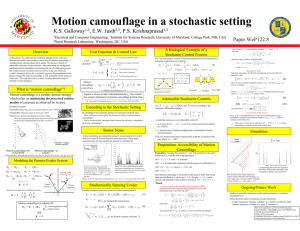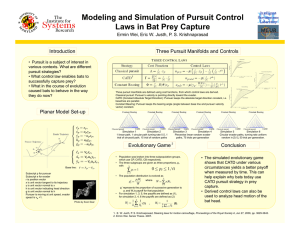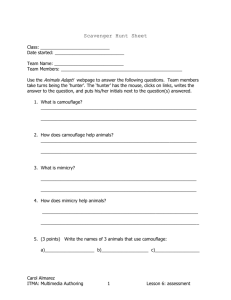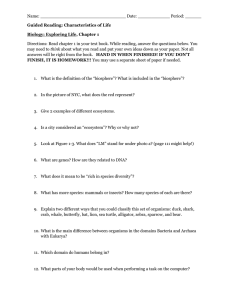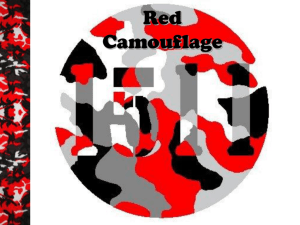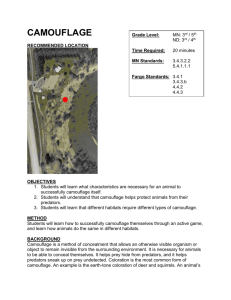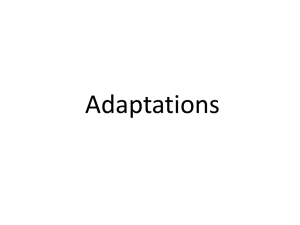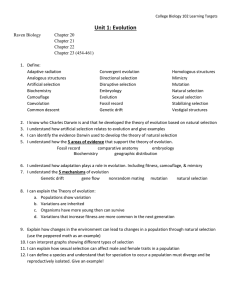Motion camouflage with sensorimotor delay
advertisement
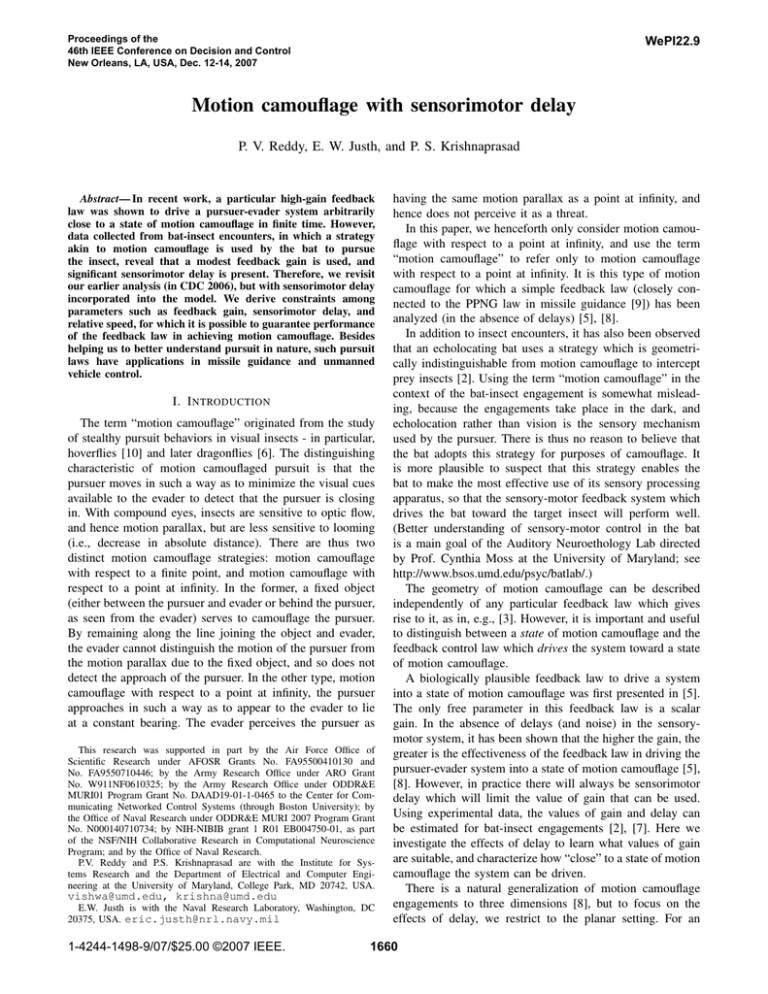
Proceedings of the
46th IEEE Conference on Decision and Control
New Orleans, LA, USA, Dec. 12-14, 2007
WePI22.9
Motion camouflage with sensorimotor delay
P. V. Reddy, E. W. Justh, and P. S. Krishnaprasad
Abstract— In recent work, a particular high-gain feedback
law was shown to drive a pursuer-evader system arbitrarily
close to a state of motion camouflage in finite time. However,
data collected from bat-insect encounters, in which a strategy
akin to motion camouflage is used by the bat to pursue
the insect, reveal that a modest feedback gain is used, and
significant sensorimotor delay is present. Therefore, we revisit
our earlier analysis (in CDC 2006), but with sensorimotor delay
incorporated into the model. We derive constraints among
parameters such as feedback gain, sensorimotor delay, and
relative speed, for which it is possible to guarantee performance
of the feedback law in achieving motion camouflage. Besides
helping us to better understand pursuit in nature, such pursuit
laws have applications in missile guidance and unmanned
vehicle control.
I. I NTRODUCTION
The term “motion camouflage” originated from the study
of stealthy pursuit behaviors in visual insects - in particular,
hoverflies [10] and later dragonflies [6]. The distinguishing
characteristic of motion camouflaged pursuit is that the
pursuer moves in such a way as to minimize the visual cues
available to the evader to detect that the pursuer is closing
in. With compound eyes, insects are sensitive to optic flow,
and hence motion parallax, but are less sensitive to looming
(i.e., decrease in absolute distance). There are thus two
distinct motion camouflage strategies: motion camouflage
with respect to a finite point, and motion camouflage with
respect to a point at infinity. In the former, a fixed object
(either between the pursuer and evader or behind the pursuer,
as seen from the evader) serves to camouflage the pursuer.
By remaining along the line joining the object and evader,
the evader cannot distinguish the motion of the pursuer from
the motion parallax due to the fixed object, and so does not
detect the approach of the pursuer. In the other type, motion
camouflage with respect to a point at infinity, the pursuer
approaches in such a way as to appear to the evader to lie
at a constant bearing. The evader perceives the pursuer as
This research was supported in part by the Air Force Office of
Scientific Research under AFOSR Grants No. FA95500410130 and
No. FA9550710446; by the Army Research Office under ARO Grant
No. W911NF0610325; by the Army Research Office under ODDR&E
MURI01 Program Grant No. DAAD19-01-1-0465 to the Center for Communicating Networked Control Systems (through Boston University); by
the Office of Naval Research under ODDR&E MURI 2007 Program Grant
No. N000140710734; by NIH-NIBIB grant 1 R01 EB004750-01, as part
of the NSF/NIH Collaborative Research in Computational Neuroscience
Program; and by the Office of Naval Research.
P.V. Reddy and P.S. Krishnaprasad are with the Institute for Systems Research and the Department of Electrical and Computer Engineering at the University of Maryland, College Park, MD 20742, USA.
vishwa@umd.edu, krishna@umd.edu
E.W. Justh is with the Naval Research Laboratory, Washington, DC
20375, USA. eric.justh@nrl.navy.mil
1-4244-1498-9/07/$25.00 ©2007 IEEE.
having the same motion parallax as a point at infinity, and
hence does not perceive it as a threat.
In this paper, we henceforth only consider motion camouflage with respect to a point at infinity, and use the term
“motion camouflage” to refer only to motion camouflage
with respect to a point at infinity. It is this type of motion
camouflage for which a simple feedback law (closely connected to the PPNG law in missile guidance [9]) has been
analyzed (in the absence of delays) [5], [8].
In addition to insect encounters, it has also been observed
that an echolocating bat uses a strategy which is geometrically indistinguishable from motion camouflage to intercept
prey insects [2]. Using the term “motion camouflage” in the
context of the bat-insect engagement is somewhat misleading, because the engagements take place in the dark, and
echolocation rather than vision is the sensory mechanism
used by the pursuer. There is thus no reason to believe that
the bat adopts this strategy for purposes of camouflage. It
is more plausible to suspect that this strategy enables the
bat to make the most effective use of its sensory processing
apparatus, so that the sensory-motor feedback system which
drives the bat toward the target insect will perform well.
(Better understanding of sensory-motor control in the bat
is a main goal of the Auditory Neuroethology Lab directed
by Prof. Cynthia Moss at the University of Maryland; see
http://www.bsos.umd.edu/psyc/batlab/.)
The geometry of motion camouflage can be described
independently of any particular feedback law which gives
rise to it, as in, e.g., [3]. However, it is important and useful
to distinguish between a state of motion camouflage and the
feedback control law which drives the system toward a state
of motion camouflage.
A biologically plausible feedback law to drive a system
into a state of motion camouflage was first presented in [5].
The only free parameter in this feedback law is a scalar
gain. In the absence of delays (and noise) in the sensorymotor system, it has been shown that the higher the gain, the
greater is the effectiveness of the feedback law in driving the
pursuer-evader system into a state of motion camouflage [5],
[8]. However, in practice there will always be sensorimotor
delay which will limit the value of gain that can be used.
Using experimental data, the values of gain and delay can
be estimated for bat-insect engagements [2], [7]. Here we
investigate the effects of delay to learn what values of gain
are suitable, and characterize how “close” to a state of motion
camouflage the system can be driven.
There is a natural generalization of motion camouflage
engagements to three dimensions [8], but to focus on the
effects of delay, we restrict to the planar setting. For an
1660
46th IEEE CDC, New Orleans, USA, Dec. 12-14, 2007
WePI22.9
expanded investigation of delay and feedback gain in motion
camouflage pursuit, see [7].
This paper is organized as follows. In Section II, the
motion camouflage model from [5] is summarized. In Section
III, a sensorimotor delay (or equivalently, a feedback delay)
is introduced, and the system with delay is analyzed along
the lines of the analysis in [5] for the delay-free setting.
In Section IV, an interpretation of the analytical results is
given, and in Section V, a numerical example is presented
for further illustration. Finally, conclusions and directions for
future work are contained in Section VI.
II. M OTION CAMOUFLAGE MODEL
The pursuer and evader are modeled as point particles
which move at constant speed in the plane subject to steering control. Generalization to three-dimensional motion and
arbitrary positive speeds is described in [8]. However, to
focus on the effects of delay, we restrict attention to the
simpler setting of planar motion with constant speeds, and
note that the generalization to three-dimensional motion and
non-constant speeds is straightforward. For zero delay, the
analysis here reduces precisely to the one presented in [5].
A. Trajectory and frame evolution
Particles moving at constant speed subject to continuous
steering controls trace out trajectories which are C 2 , i.e.,
which are twice continuously differentiable. Without loss of
generality, we may assume that the pursuer particle moves
at unit speed, and the evader particle moves at speed ν > 0
(i.e., ν corresponds to the ratio of speeds of the pursuer and
evader).
The motion of the pursuer is described by
ṙp = xp ,
ẋp = yp up ,
ẏp = −xp up ,
Fig. 1. Illustration of the trajectories and natural Frenet frames for the
planar pursuer-evader engagement. (Figure from [5].)
We define the notation q⊥ to represent the vector q rotated
counter-clockwise in the plane by an angle π/2 [5], [8].
When there is no delay associated with incorporating sensory
information into the feedback law, we let
r
⊥
up = −µ
· ṙ
,
(4)
|r|
where µ > 0 is a gain parameter [5], [8]. However, if there
is a delay τ in the incorporation of sensory information, then
we substitute up (t − τ ) for up in equation (1).
Observe that (4) is only well defined for |r| =
6 0. For this
feedback law, it is assumed that |r| 6= 0 initially, and the
engagement is analyzed (for finite time) until |r| reaches a
value r0 > 0 [5], [8].
C. Distance from motion camouflage
The function
(1)
Γ=
and the motion of the evader is described by
ṙe = νxe ,
ẋe = νye ue ,
ẏe = −νxe ue ,
(2)
where the steering control of the evader, ue , is prescribed,
and the steering control of the pursuer, up , is given by a
feedback law. The orthonormal frame {xp , yp }, which is the
planar natural Frenet frame for the pursuer particle, evolves
with time as the pursuer particle moves along its trajectory
(described by rp ). Similarly, {xe , ye } is the planar natural
Frenet frame corresponding to the evader particle [1], [4].
Here we assume ν < 1, so that the pursuer moves faster
than the evader. Figure 1 illustrates (1) and (2).
B. Feedback law for motion camouflage
We define
r = rp − re ,
(3)
r
ṙ
·
|r| |ṙ|
(5)
describes how far the pursuer-evader system is from a state of
motion camouflage [5], [8]. The system is in a state of motion
camouflage when Γ2 = 1, with Γ = −1 corresponding to
pure shortening of the baseline vector, and Γ = +1 corresponding to pure lengthening. The difference Γ−(−1) > 0 is
a measure of the distance of the pursuer-evader system from
a state of motion camouflage (with baseline shortening).
For (5) to be well defined, we must have |r| > 0 (as
discussed in the previous subsection), as well as |ṙ| > 0.
However, the latter condition is ensured by the assumption
that 0 < ν < 1, since |ṙ| ≥ 1 − ν.
Differentiating Γ along trajectories of (1) and (2) gives
ṙ · ṙ + r · r̈
r · ṙ
r · ṙ
r · ṙ
ṙ · r̈
Γ̇ =
−
−
|r||ṙ|
|ṙ|
|r|3
|r|
|ṙ|3
|ṙ|
1 r
r
ṙ
ṙ
=
1 − Γ2 +
−
·
· r̈.
(6)
|r|
|ṙ| |r|
|r| |ṙ| |ṙ|
Defining w by
so that r is the relative position of the pursuer with respect
to the evader, and we refer to r as the “baseline vector.”
1661
w=−
r
⊥
· ṙ
,
|r|
(7)
46th IEEE CDC, New Orleans, USA, Dec. 12-14, 2007
so that up = µw, and noting that
"
⊥ # ⊥
r
r
ṙ
ṙ
ṙ
ṙ
r
−
·
=
·
|r|
|r| |ṙ| |ṙ|
|r|
|ṙ|
|ṙ|
w
= − 2 ṙ⊥ ,
(8)
|ṙ|
we see that (6) becomes
Γ̇ =
|ṙ|
1
w ⊥
ṙ
1 − Γ2 −
· r̈.
|r|
|ṙ| |ṙ|2
(9)
Furthermore, ṙ⊥ = yp −νye , and r̈ = yp up (t−τ )−ν 2 ye ue ,
so that
ṙ⊥ · r̈ = [1 − ν(xp · xe )] up (t − τ ) + ν 2 [ν − (xp · xe )] ue .
(10)
Thus,
w
1
|ṙ|
[1 − ν(xp · xe )] up (t − τ )
1 − Γ2 −
Γ̇ =
|r|
|ṙ| |ṙ|2
1
w
−
ν 2 [ν − (xp · xe )] ue
|ṙ| |ṙ|2
|ṙ|
1
w
2
≤
1−Γ −
[1 − ν(xp · xe )] up (t − τ )
|r|
|ṙ| |ṙ|2
2
|w| ν (1 + ν)
umax .
(11)
+
|ṙ| (1 − ν)2
where umax = max |ue |. We would like to understand what
happens to the term involving up (t − τ ) above, since this is
where the effects of sensorimotor delays enter our model.
WePI22.9
for |r| > r0 . From (11) we then obtain
|ṙ|
1
w
Γ̇ ≤
[1 − ν(xp · xe )] up
1 − Γ2 −
|r|
|ṙ| |ṙ|2
1
w
[1 − ν(xp · xe )] (up (t − τ ) − up )
−
|ṙ| |ṙ|2
2
|w| ν (1 + ν)
+
umax
|ṙ| (1 − ν)2
µ
|ṙ|
2
≤ − 1−Γ
[1 − ν(xp · xe )] −
|ṙ|
|r|
2
|w| ν (1 + ν)
umax
+
|ṙ| (1 − ν)2
1
+ 2 [1 − ν(xp · xe )] |up (t − τ ) − up |
|ṙ|
1−ν
1+ν
2
≤ − 1−Γ
µ
−
1+ν
r0
p
1
+
ν
+ 1 − Γ2
(1 − ν)2
(1 + ν)2
2
2
× ν umax + τ µ
+ µ(1 + ν) + ν umax ,
2r0
(17)
for |r| ≥ r0 . Taking
c0 = µ
and
III. D ELAY ANALYSIS
In particular, we decompose up (t − τ ) into two terms:
up (t − τ ) = up (t) + [up (t − τ ) − up (t)] .
c1 =
(12)
(13)
Also,
Thus,
|ẇ| ≤
(1 + ν)2
+ µ(1 + ν) + ν 2 umax ,
2r0
(15)
for |r| > r0 , and therefore
|up (t − τ ) − up (t)|
(1 + ν)2
2
≤ τµ
+ µ(1 + ν) + ν umax ,
2r0
−
1+ν
,
r0
ν 2 (1 + ν)umax
,
(1 − ν)2
(18)
(19)
p
Γ̇ ≤ − 1 − Γ2 c0 + 1 − Γ2 c1 + τ µ
(1 + ν)2
1+ν
× c1 +
+
µ(1
+
ν)
,
(1 − ν)2
2r0
(20)
for |r| > r0 , where we note that c0 depends on µ. Observe
that for the term −(1 − Γ2 )c0 to be negative, we require
c0 > 0. Thus, we require µ to satisfy the lower bound
d
r
r
⊥
⊥
ẇ = −
· ṙ +
· r̈
dt |r|
|r|
1
r
r
r
= −
ṙ −
· ṙ
· ṙ⊥ +
· r̈⊥
|r|
|r|
|r|
|r|
1
r
r
r
=
· ṙ
· ṙ⊥ −
· r̈⊥
(14)
|r| |r|
|r|
|r|
(17) can be rewritten as
We know from the analysis for delay τ = 0 that the first
term on the right-hand-side of (12) will help us to achieve
Γ̇ ≤ 0 (under certain conditions). The second term in (12)
is something we would like to bound.
By the Mean Value Theorem, since up is continuous, there
exists t∗ ∈ (t − τ, t) such that
up (t − τ ) − up (t) = −τ u̇p (t∗ ) = −τ µẇ(t∗ ).
1−ν
1+ν
µ>
(1 + ν)2
.
(1 − ν)r0
(21)
Following the methodology of the proof of Proposition
3.3 in [5], suppose that we are given 0 < << 1. If
1
c0 > √ c1 + τ µ
1+ν
(1 + ν)2
× c1 +
+
µ(1
+
ν)
,
(1 − ν)2
2r0
(22)
then for |r| > r0 and (1 − Γ2 ) > , (20) implies
(16)
1662
Γ̇ ≤ −(1 − Γ2 )c2 ,
(23)
46th IEEE CDC, New Orleans, USA, Dec. 12-14, 2007
where
1
c2 = c0 − √ c1 + τ µ
1+ν
(1 + ν)2
× c1 +
+
µ(1
+
ν)
(1 − ν)2
2r0
> 0.
(24)
We are thus led to the following result.
Proposition: Consider the system (1) with (2) and control
law (4), subject to a time delay τ > 0, 0 < << 1, and the
following hypotheses:
(A1) 0 < ν < 1 (and ν is constant),
(A2) ue is continuous and |ue | is bounded,
(A3) Γ0 = Γ(0) < 1 − , and
(A4) |r(0)| > 0.
Let 0 < r0 < |r(0)|, and
1+ν
1 + Γ0
2−
1
ln
.
δ = max 0,
2 |r(0)| − r0
1 − Γ0
(25)
Then there exists a finite time t1 for which Γ(t1 ) ≤ −1 + (i.e., motion camouflage is accessible in finite time), provided
there exists a value of µ > 0 which satisfies (21) and
1
c2 = c0 − √ c1 + τ µ
1+ν
(1 + ν)2
× c1 +
+ µ(1 + ν)
(1 − ν)2
2r0
> δ,
(26)
where c0 and c1 are given by (18) and (19), respectively.
WePI22.9
Remark: For τ = 0, Proposition 3.3 in [5] guarantees
the existence of (a range of) values of µ which meet the
requirements of the above Proposition for any choice of
> 0, 0 < ν < 1, |r(0)| > 0, and Γ0 < 1. .
IV. I NTERPRETATION
Although the Proposition above gives inequalities for the
gain µ which, if satisfied, ensure that the system with delay
passes within a tolerance of the motion camouflage state
in finite time, the physical meaning of the inequalities is not
immediately transparent. To clarify the interpretation of these
inequalities, it is useful to first consider the limit of large r0 .
A. r0 → ∞ limit
Let us consider the limiting situation in the Proposition as
r0 becomes very large, so that terms involving 1/r0 may be
neglected in the expressions which constrain the permissible
values of the feedback gain µ. We approximate
1−ν
, δ ≈ 0,
(29)
c0 ≈ µ
1+ν
and seek µ satisfying
1+ν
1
c2 = c0 − √ c1 + τ µ c1 +
µ(1 + ν)
(1 − ν)2
"
2 !#
1−ν
1
1+ν
= µ
− √ c1 + τ µ c1 + µ
1+ν
1−ν
> 0.
(30)
A necessary condition for the existence of a positive value
of µ satisfying (30) is
τ c1
1−ν
√ <
.
1+ν
Proof: We define
T =
|r(0)| − r0
> 0,
1+ν
(27)
and note that T is a lower bound on the interval of time over
which we can guarantee that |r| > r0 . Then (as shown in
[5]), for
tanh−1 Γ0 − 12 ln 2−
c2 ≥ (1 + ν)
|r(0)| − r0
1+Γ0
1
1
ln
−
ln
2
1−Γ0
2
2−
= (1 + ν)
|r(0)| − r0
1
1+ν
1 + Γ0
2−
=
ln
,
2 |r(0)| − r0
1 − Γ0
(28)
we are guaranteed to achieve Γ(t1 ) ≤ −1 + at some finite
time t1 ≤ T . Recalling condition (24), we note that Γ(t1 ) ≤
−1 + at some finite time t1 ≤ T provided c2 > δ ≥ 0. Remark: By taking |r(0)| arbitrarily large, δ may be made
arbitrarily close to zero. Intuitively, this means that a large
initial separation facilitates reaching the motion camouflage
state. Corresponding remarks can be made about the effects
of Γ0 and on δ, as well. (31)
If (31) is satisfied, then the value of µ which maximizes (30)
is easily shown to be
2 √ 1−ν
1−ν
τ c1
µ0 =
− √ .
(32)
2τ 1 + ν
1+ν
One √
way to approach (32) is to constrain τ and such
that τ / = ξ = constant, and to insist that ξ satisfy
τ
1 1−ν
√ = ξ < ξ0 =
.
(33)
c1 1 + ν
Then (32) becomes
c1
µ0 =
2
1−ν
1+ν
2
ξ0
ξ
ξ
1−
ξ0
(34)
If we further choose ξ/ξ0 = η ∈ (0, 1/2), then we obtain
2 c1 1 − ν
1
ν 2 umax 1
µ0 =
−1 =
−1 .
2 1+ν
η
2(1 + ν) η
(35)
Thus, in order to obtain an interpretation of the constraints
on µ for the limiting case of r0 large, we performed
the
√
following steps: (1) we constrained the ratio τ / to be
constant, (2) we further constrained the value of this ratio
to be less than 1/2 of its maximum possible value (which
1663
46th IEEE CDC, New Orleans, USA, Dec. 12-14, 2007
WePI22.9
is a tradeoff between ensuring that µ0 satisfies (30) and
permitting to be as small as possible for a given τ ), and
(3) we obtained an expression for the gain that only involves
the ratio of speeds and maneuverability of the evader.
B. Finite r0
Following a similar procedure as above, we easily compute
the maximum allowable value of µ in (24) to be
2
√ 1−ν
µ0 =
2τ 1 + ν
1−ν
(1 + ν)2
τ
1+ν
×
− √ c1 +
,
1+ν
(1 − ν)2
2r0
2 √ 1−ν
1−ν
τ
(1 + ν)3
,
=
− √ c1 +
2τ 1 + ν
1+ν
2r0 (1 − ν)2
(36)
Fig. 2. Evader trajectory with sinusoidally varying steering control (dark
line), and the corresponding pursuer trajectory (dashed dark line), evolving
according to (1) and (2), with pursuer control given by (4).
but in addition, from (21), we have
(1 + ν)2
.
(37)
(1 − ν)r0
√
Once again, we use ξ = τ / , however in place of ξ0 , we
now have
−1
1−ν
(1 + ν)3
ζ0 =
c1 +
,
(38)
1+ν
2r0 (1 − ν)2
µ0 >
so that
1
2
(1 + ν)3
2r0 (1 − ν)2
2
ζ0
ξ
1−
.
ξ
ζ0
(39)
If we further choose ξ/ζ0 = η ∈ (0, 1/2), then we obtain
2 1
(1 + ν)3
1−ν
1
−1
µ0 =
c1 +
2
2r0 (1 − ν)2
1+ν
η
2
ν umax
1+ν
1
=
+
−1 .
(40)
2(1 + ν)
4r0
η
µ0 =
c1 +
1−ν
1+ν
Thus, the term involving r0 is balanced against the term
involving c1 (and, in turn, the relative maneuverability of
the pursuer and evader).
V. N UMERICAL EXAMPLE
Figure 2 illustrates trajectories of the pursuer-evader system (1)-(2) under control law (4) for the pursuer and a
sinusoidal steering control for the evader. The straight lines
between the trajectories in figure 2 connect corresponding
positions of the pursuer and evader at discrete, equally spaced
moments in time. When these lines are parallel to each other,
Γ = −1, and the system is in a state of motion camouflage
[5], [8]. At the scale of figure 2, which corresponds to
essentially zero feedback delay τ and a modest value for the
gain µ, we see that the system quickly approaches a state of
motion camouflage in this example.
We seek to illustrate the effects of sensorimotor delay on
the performance of the pursuer for the example of figure 2.
The parameter values used are ν = 0.9, umax = 0.25, and
r0 = 5. The evader steering control ue is sinusoidal with
amplitude umax . Because ν is close to one, the analytically
Fig. 3. Peak deviation from a motion camouflage state, , plotted as a
function of increasing feedback gain µ for the delay-free case (i.e., τ = 0).
derived constraints (21) and (24) are expected to be overly
conservative for this example. Nevertheless, the trends identified among τ , µ, and from the analysis are expected to
hold. Figures 3 and 4 confirm these trends.
For the delay-free case (i.e., τ = 0), (24) becomes
c1
1−ν
1+ν
c1
c2 = c0 − √ = µ
−
− √ > 0, (41)
1+ν
r0
so that increasing the feedback gain µ permits smaller
values of to satisfy the inequality. A higher value of µ
also increases the rate at which the pursuer-evader system
is driven toward a state of motion camouflage. Figure 3
shows the peak deviation of Γ from −1 (excluding an initial
transient), as a function of µ, for zero feedback delay (i.e., for
τ = 0). In keeping with the conclusion of the Proposition,
i.e., that there exists a finite time t1 such that Γ(t1 ) ≤ −1+,
we identify this peak deviation of Γ from -1 with . Then for
µ greater than about 1.5, increasing the value of µ in figure
3 is observed to reduce .
Figure 4 shows versus µ corresponding to a feedback
delay τ = .045. The best performance is obtained for µ near
1664
46th IEEE CDC, New Orleans, USA, Dec. 12-14, 2007
Fig. 4. Peak deviation from a motion camouflage state, , plotted as a
function of increasing feedback gain µ in the presence of a sensorimotor
delay τ = .045.
4: for smaller values of µ, poorer performance is obtained,
and for larger values of µ, the system fails to even approach
a state of motion camouflage. (Recall that an upper bound
on µ is reflected in (24).)
VI. C ONCLUSIONS AND FUTURE WORK
There are several types of conclusions that can be reached
through the approach outlined above for pursuit systems
with sensorimotor or feedback delays: some apply more
to biological systems, and others more to engineered systems. On the biological side, sensorimotor delay is a key
performance parameter for the pursuer, as is the feedback
gain µ. Although not explored here, biologically optimized
values for µ are presumably influenced by sensor noise as
well as by the flight performance or maneuverability of
the pursuer. In control system design, we often think of
gains as parameters at our disposal to optimize closed-loop
performance. However, for biological motion camouflaged
pursuit, it may be more compelling to think of the feedback gain as predetermined (by physical considerations) and
the delay as the quantity “nature” tries to optimize (i.e.,
minimize). This could be accomplished through reflexive
(rather than reflective) responses to sensory input, as well as
through streamlining the sensory processing itself. In recent
work [7], we have extracted the gain and delay values from
data collected during bat-insect engagements as part of the
process of developing an understanding of the sensorimotor
design of the bat.
In our formulation of motion camouflaged pursuit, the
pursuer sensor measurement (i.e., the transverse component
of relative velocity) is (proportionally) fed back to control the
motion of the pursuer. If the pursuer were able to predict future values of the transverse relative velocity, then the effects
of feedback delay could be mitigated. For example, a sensor
measurement of time rate of change of transverse relative
velocity would be useful for this purpose. A model which
keeps track of both the pursuer (center-of-mass) motion and
the pursuer sensor orientation might be useful for analyzing
WePI22.9
this additional feedback mechanism. In the echolocating bat,
the head direction corresponds to the sensor orientation, and
need not be aligned with the motion of the bat (although it is
often observed that when the bat turns its head, there is then
a tendency for the bat to bring its motion into alignment with
its new head direction). Allowing for control of the sensor
orientation independently from the direction of motion could
be expected to simplify the task of directly sensing the rate
of change of transverse relative velocity.
On the engineering side, an important practical problem
is unmanned vehicle control over a wireless communication
link. As pointed out in [5], [8], there is a close connection
between motion camouflage and control laws used for missile
guidance [9]. In this context, control over a wireless link
could be used as part of the process of control system
integration, or it could be used to guide the vehicle using
an external sensor. In either case, satisfying the hypotheses
of the Proposition results in a performance guarantee. If
the rate of change of the transverse component of relative
velocity can be sensed, then this quantity can presumably be
fed back (along with the transverse relative velocity itself)
to mitigate the effects of delay. If a detailed model of the
target (i.e., the evader) is available, then a more targetspecific approach could be used to predict target motion from
the available (possibly distributed) sensor measurements.
However, this deviates somewhat from the theme of simple,
sensor-driven feedback laws for pursuit.
The work presented here is an initial foray into analyzing
steering (or curvature) based control systems with feedback
delays. By exploiting the specific structure of models based
on trajectories and natural Frenet frames, we hope to derive
results for other classes of nonlinear systems with delay.
We then seek to learn how such results can inform our
understanding of biological data, as well as provide guidance
for the design of control systems for (teams of) unmanned
vehicles.
R EFERENCES
[1] R.L. Bishop, “There is more than one way to frame a curve,” The
American Mathematical Monthly, Vol. 82, No. 3, pp. 246-251, 1975.
[2] K. Ghose, T. Horiuchi, P.S. Krishnaprasad and C. Moss, “Echolocating
bats use a nearly time-optimal strategy to intercept prey,” PLoS
Biology, 4(5):865-873, e108, 2006.
[3] P. Glendinning, “The mathematics of motion camouflage,” Proc. Roy.
Soc. Lond. B, Vol. 271, No. 1538, pp. 477-481, 2004.
[4] E.W. Justh and P.S. Krishnaprasad, “Natural frames and interacting
particles in three dimensions,” Proc. 44th IEEE Conf. Decision and
Control, 2841-2846, 2005 (see also arXiv:math.OC/0503390v1).
[5] E.W. Justh and P.S. Krishnaprasad, “Steering laws for motion camouflage,” Proc. R. Soc. A, Vol. 462, pp. 3629-3643, 2006 (see also
arXiv:math.OC/0508023).
[6] A.K. Mizutani, J.S. Chahl, and M.V. Srinivasan, “Motion camouflage
in dragonflies,” Nature, Vol. 423, p. 604, 2003.
[7] P.V. Reddy, “Steering laws for pursuit,” M.S. Thesis, University of
Maryland, 2007.
[8] P.V. Reddy, E.W. Justh and P.S. Krishnaprasad, “Motion camouflage
in three dimensions,” Proc. 45th IEEE Conf. Decision and Control,
pp. 3327-3332, 2006 (see also arXiv:math.OC/0603176).
[9] N.A. Shneydor, Missile Guidance and Pursuit, Horwood, Chichester,
1998.
[10] M.V. Srinivasan and M. Davey, “Strategies for active camouflage of
motion,” Proc. Roy. Soc. Lond. B, Vol. 259, No. 1354, pp. 19-25, 1995.
1665
